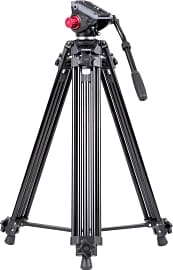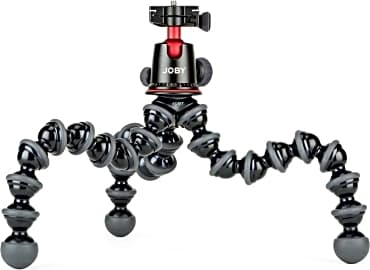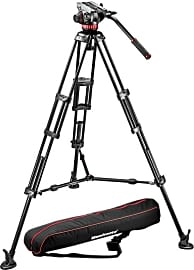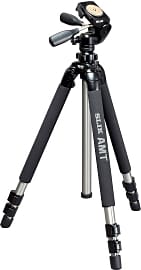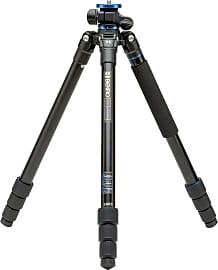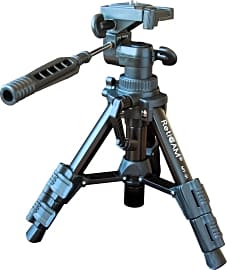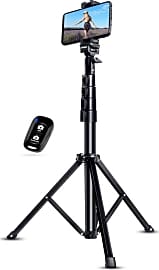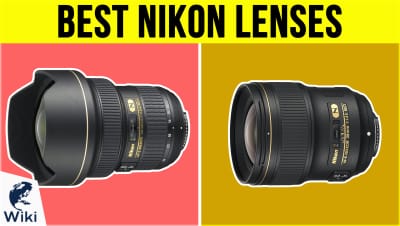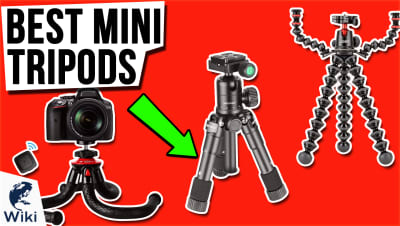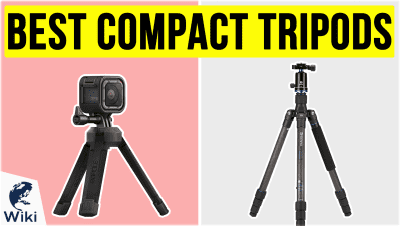The 10 Best Tripods

This wiki has been updated 40 times since it was first published in May of 2015. Whether you're a professional photographer, a dedicated birder, or an amateur looking to take your hobby to the next level, a quality tripod can be a worthwhile investment. We've selected some of the finest camera hardware on the market, rated here by durability, versatility, and portability. We've included standard models, as well as some specialized options good for travel, vlogging, and more. When users buy our independently chosen editorial choices, we may earn commissions to help fund the Wiki.
Editor's Notes
February 09, 2021:
Since tripods are no longer used exclusively by professional photographers and videographers, we added a few options that are good choices for vloggers. The UBeesize Extendable is an affordable and lightweight option that comes with a phone mount as well as a GoPro adapter. While it's not stable enough for professional use, it's a good choice for beginners, and its standard 1/4" screw can accommodate a camera as well. The RetiCam Tabletop is sturdy enough to hold a DSLR and is a good choice for filming yourself at a desk or for taking macro images of food or products. The Joby GorillaPod is another mini option, though this one is more versatile because of its flexible legs, which can grip onto a tree branch or pole. Also new to the list, the Andoer Heavy Duty is a good option for those who need extra support for their heavy equipment.
May 01, 2019:
Without much in the way of new, high end models hitting the market, this year's ranking mostly contains products seen last time around, though their positions on our list have moved around quite a bit thanks to certain offerings proving themselves in the field and others dealing with some quality issues that might have cost them a few slots. The only real new product is the 3-Series Mach 3 from Benro, which comes in to replace the 2-Series. This is a case in which the 2-Series is struggling with availability issues, and the 3-Series has proved to be the more effective option of the pair. Yes, it's a little heavier and a little shorter, but those minor inconveniences are trumped by the fact that it can hold nearly six more pounds of gear.
Elsewhere, the Manfrotto that was our previous number one pick swapped with our old number three simply because the excellent video head that comes with the Manfrotto is just a little less versatile than the simple, but outstanding ball head that comes with the Gitzo. I happen to own and love that Manfrotto tripod, but I'm a cinematographer. If you don't make movies or bird watch, it's simply less useful. Also, the Vanguard previously at number two took a big dip due to construction quality issues with its rotating central column — a big bummer considering that it's probably the device's most exciting feature.
Steady As She Goes
–the steadiness of your camera is the one thing over which you ought to exert your will, for it is that steadiness that will translate to uncanny sharpness.
There are only two types of photographers that don't need tripods: street photographers and war correspondents. Both of those genres tend to gain a little extra impact when there's a reminder of the photographer in the image, a sense that the camera was there in the hands of a real human being whose interaction with his or her subject was a thing of beautiful chance or of terrible danger.
For everyone else–landscape and nature photographers, portrait artists, headshot photographers, and the rest–tripods are an absolute necessity. The required sharpness of our images depends on them. For the record, I consider wedding photographers to be a kind of war correspondent.
Among all the momentary variables you can't control in the sharpness of your images–the movement of your subjects, the quality of your lenses, etc.–the steadiness of your camera is the one thing over which you ought to exert your will, for it is that steadiness that will translate to uncanny sharpness.
A good tripod relies on the simple mathematical fact that a triangle is the steadiest geometric formation. A mass evenly distributed onto three legs will vibrate less than any other configuration of supports, even at significant heights.
To reach those heights, tripods will use two to four leg sections in decreasing diameter, all layered into one another like cylindrical Russian nesting dolls. You release the sections by way of a locking tab or screw mechanism that you then re-tighten to keep a whatever height you select consistent.
Once in position, your camera attaches to the tripod by way of a small screw that is standardized across the industry. Often, this screw lives on something called a quick-release plate, which allows you to take the camera off your tripod head and reattach it again without having to do all that pesky screwing.
Those tripod heads differ from model to model, as well, and each has its specific benefit depending on your intended use, which will help you determine which tripod is right for you.
It's All In Your Head
It's important to evaluate your tripod options based on what you actually want to shoot with a camera mounted on it. Depending largely on your subject and your shooting environment, your choice of tripod could vary significantly.
The head that comes with each of the tripods on our list is probably the first place you should start to compare units. If you're shooting landscape and portrait photography, you need a simple head that you can set up and lock without going back to it for very many adjustments. The best type of head for this is also usually the least expensive type, which is the ball head.
On a ball head mount, your camera sits on a small platform that sticks out from a ball living inside of a joint.
On a ball head mount, your camera sits on a small platform that sticks out from a ball living inside of a joint. It greatly resembles the human shoulder in this regard, except that you can tighten, loosen, and sometimes lock this joint into place. The downside to these heads is that they aren't suitable for tracking moving subjects, and they tend to be weaker with heavier camera loads.
The sturdiest among head designs is the pan and tilt head, which has two arms jutting out from its center, each of which controls a single axis, allowing you to tilt the camera forward and backward, as well as side to side. When you loosen the bottom portion of this head, you can pan 360˚. Like the ball head, these are not ideal for tracking subjects, but they are much stronger and their adjustments are more specific.
When you do want to track a moving subject, or if you're interested in videography, a fluid head is the head for you. These heads have one long arm sticking out the back of their bodies. With its axes loosened, you can smoothly use this arm to guide your camera along X and Y lines with subtle resistance from a fluid counterbalance system. When made to quality specifications, these tend to be the most expensive heads on the market, so if you see one for very little money, it's safe to assume that it's more trouble than it's worth.
Carbon Fiber Cometh
The tripod itself reaches back in its design to well before the advent of the camera. It found itself useful in land survey equipment, as well as the classic painter's easel.
Later, collapsible wooden tripods came along, and the item saw its transition into metals after the second World War.
Early cameras had extraordinarily long exposure times due to the rudimentary nature of their exposure plates, so both camera and subject had to remain as still as possible for minutes at a time. Photographers in those days set up their cameras on relatively tall wooden tripods that neither collapsed into their middles nor broke down into smaller components.
Later, collapsible wooden tripods came along, and the item saw its transition into metals after the second World War. In those booming post-war years, camera technology and the equipment built to support it accelerated at an incredible rate, with lighter and more durable steel tripods becoming the standard.
By the 1980s, however, experiments with carbon fibers led an exploding Japanese camera market to invest heavily in carbon fiber builds for their camera gear and other manufactured goods. Today, carbon fiber is the lightest, most durable tripod material available at a reasonable price, but if you don't mind the extra ounces, you could save a little more money by sticking with aluminum.



